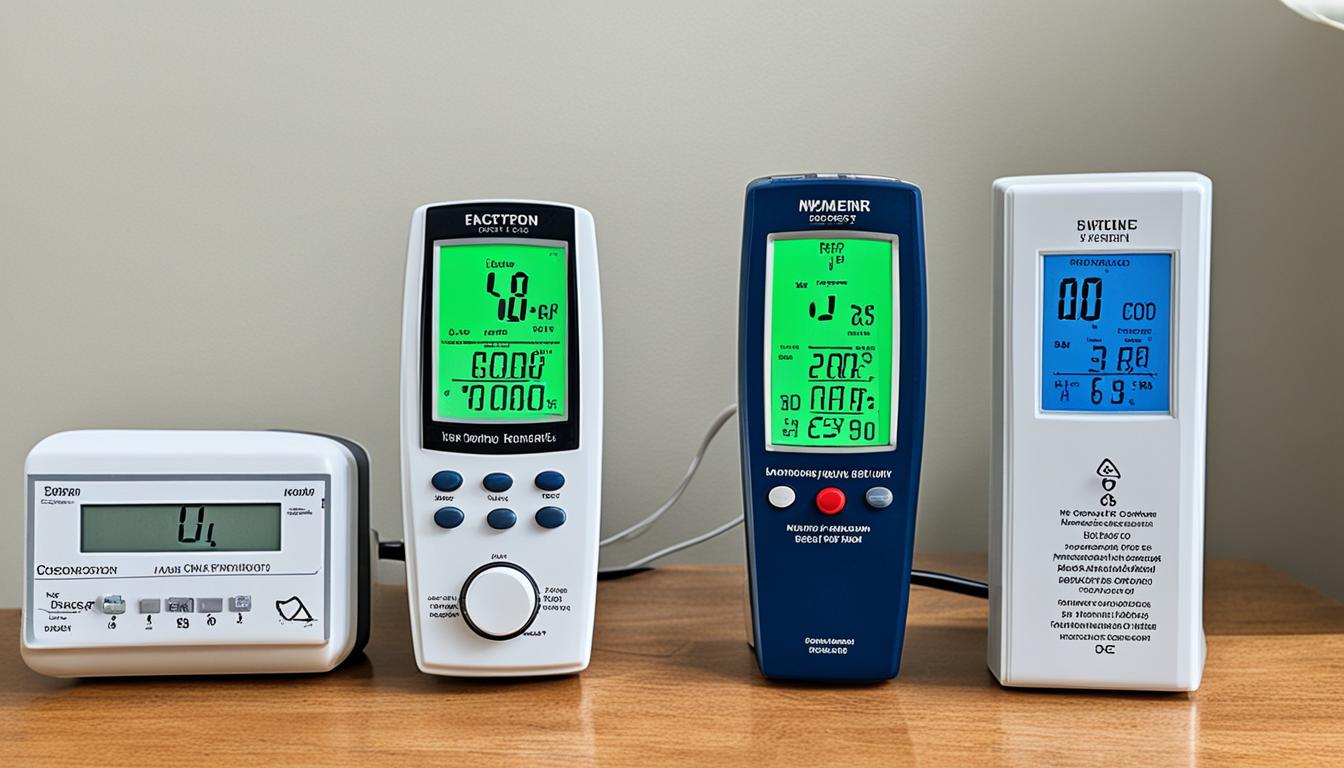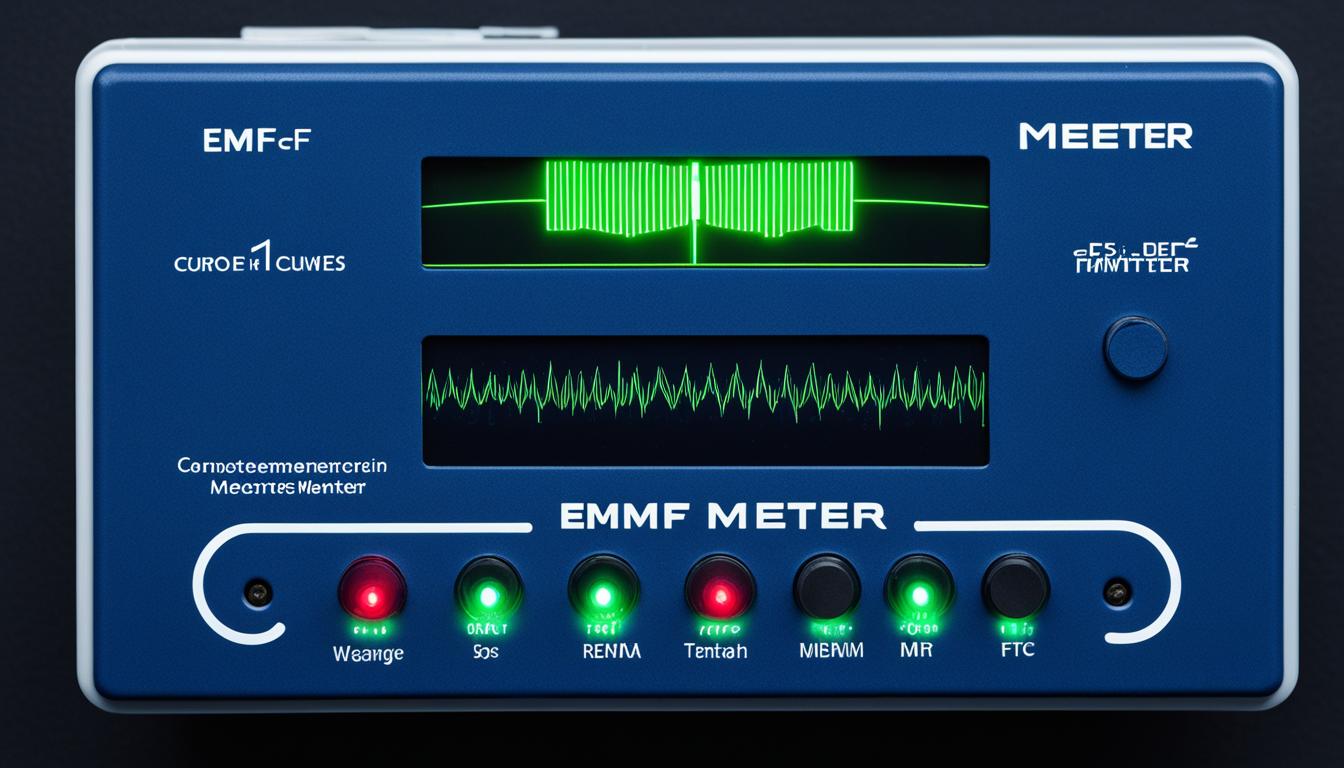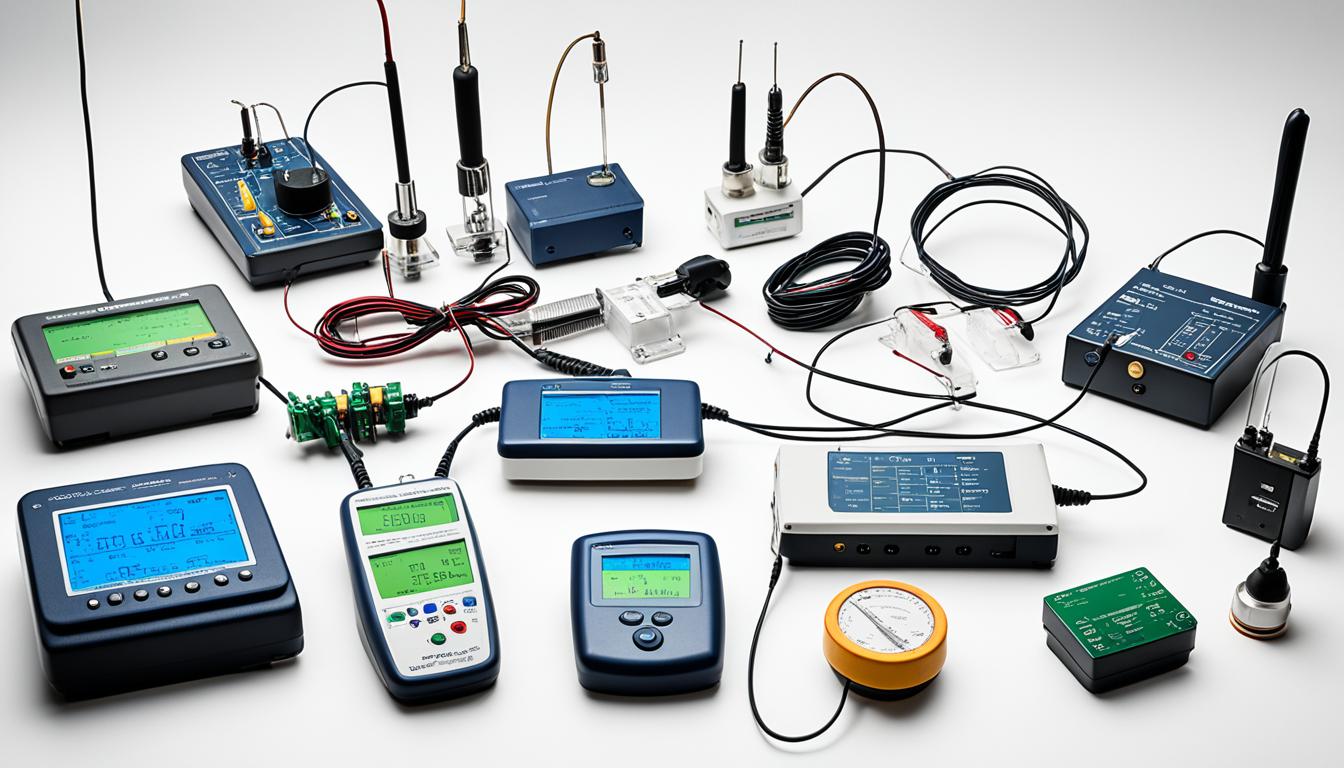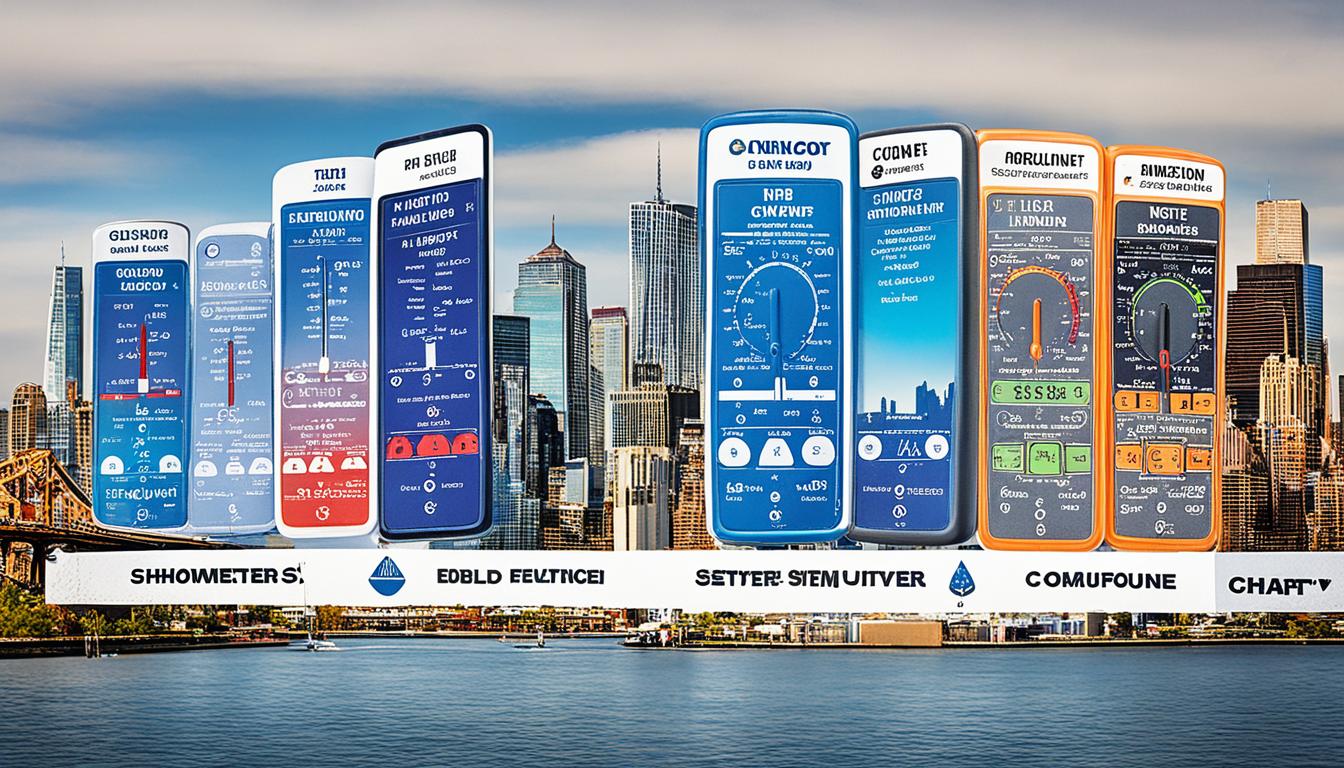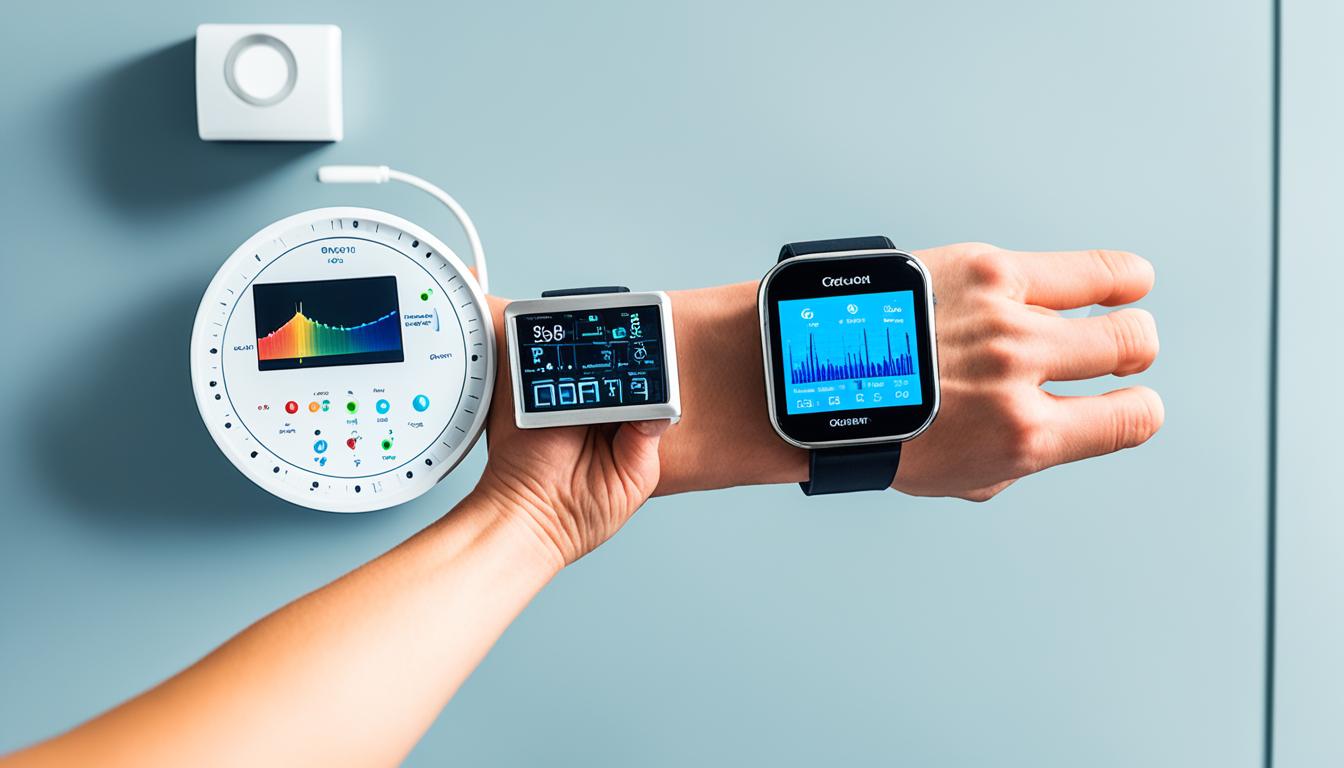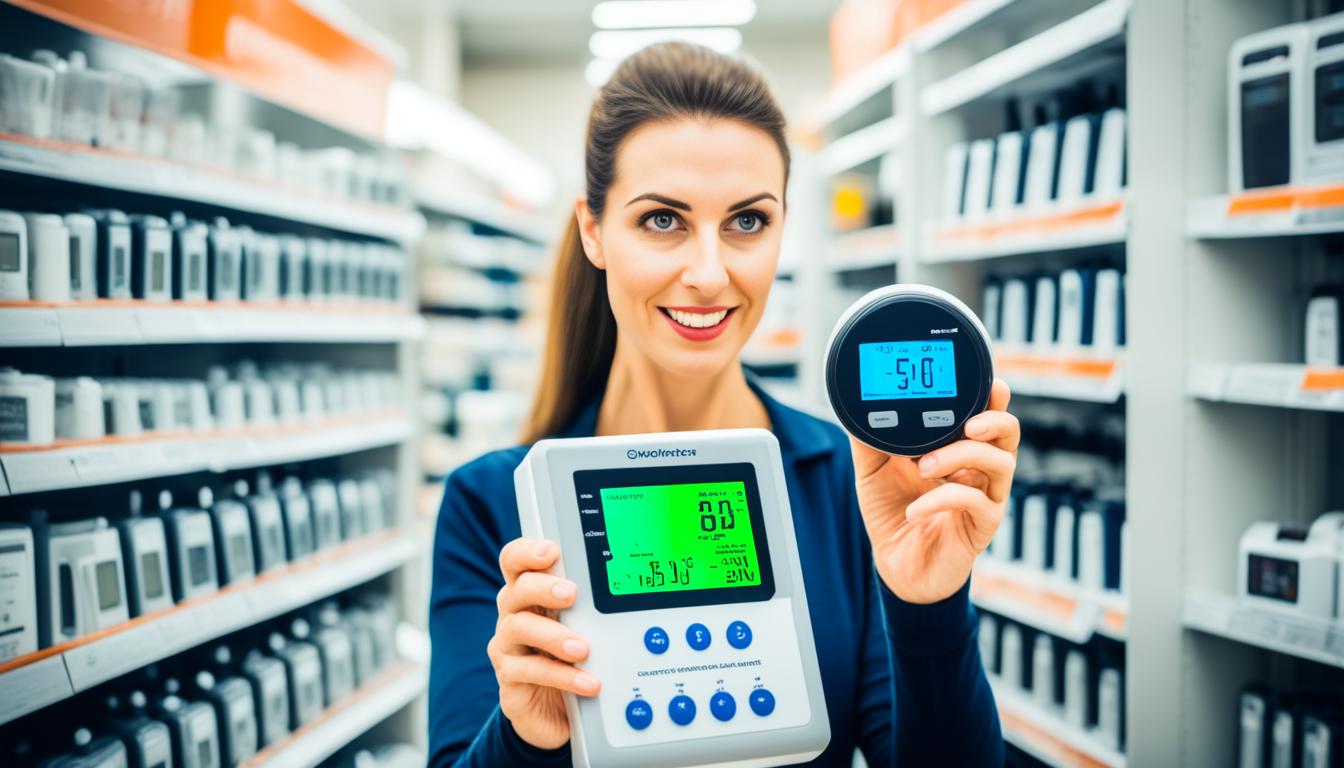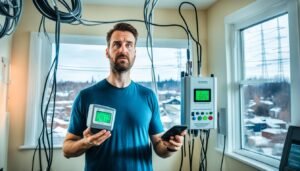Disclosure: This Post Contains Affiliate Links; We earn a commission on purchases.
Welcome to our guide on how to measure EMF levels in your environment. As our world becomes increasingly interconnected, we are surrounded by electromagnetic fields (EMF) from various sources such as cell phones, Wi-Fi routers, and electrical devices. It’s essential to understand and monitor these EMF levels to ensure your safety and well-being. In this article, we will explore different EMF measurement methods, testing techniques, and detection devices that can help you assess your EMF exposure. Let’s dive in!
Key Takeaways:
- EMF levels can be measured using various methods and devices to ensure your safety.
- Low frequency radiation meters measure electric and magnetic fields, while high frequency radiation meters measure electromagnetic fields from wireless devices.
- Radioactivity meters measure radiation from radioactive materials and radon gas.
- Choose the right EMF meter that covers the frequency range of the radiation sources you want to measure.
- Accurate measurement of EMF levels can help identify and mitigate potential health risks.
Understanding EMF and Its Impact on Health
EMF radiation, also known as electromagnetic frequencies, is a form of energy that surrounds electronic devices and power sources. It can originate from both natural sources, such as the earth’s own frequency and the sun, as well as man-made sources like Wi-Fi routers, cell phones, and other electronic devices.
Electromagnetic radiation is categorized based on its wavelength and frequency. Low-level radiation falls under the category of non-ionizing radiation, which is generally considered harmless. However, the long-term effects of low-level EMF radiation are still being studied.
On the other hand, ionizing radiation has the potential for cellular and DNA damage. It is essential to note that high-frequency EMF radiation, the most relevant type in today’s technological landscape, falls under ionizing radiation.
The International Commission on Non-Ionizing Radiation Protection (ICNIRP) sets guidelines for EMF exposure based on scientific research. Accurately measuring the levels of EMF radiation in your environment is crucial for understanding your exposure and potential health risks associated with it.
To gain a better understanding of this topic, let’s explore the different types of electromagnetic radiation and their potential health risks in more detail.
The Types of Electromagnetic Radiation
Electromagnetic radiation encompasses a wide range of frequencies and wavelengths. It includes:
- Radio waves: These have the longest wavelength and are used in communication devices like radios and televisions.
- Microwaves: These are utilized in microwave ovens and wireless communication technologies like Wi-Fi and Bluetooth.
- Infrared radiation: This type of radiation is emitted by heat sources and can be sensed as warmth.
- Visible light: This is the narrow range of electromagnetic radiation that is visible to the human eye and includes all the colors of the rainbow.
- Ultraviolet (UV) radiation: This type of radiation comes from the sun and can result in both positive and negative health effects, depending on the level of exposure.
- X-rays: X-rays are used for medical diagnostics and imaging and have higher energy than visible light.
- Gamma rays: These are the highest energy radiation and are often associated with nuclear reactions and nuclear power plants.
While low-level radiation from sources like smartphones, Wi-Fi routers, and other electronic devices is generally considered safe, it is important to monitor your exposure and take necessary precautions, especially in high-frequency electromagnetic fields.
Different Types of EMF Meters and Their Uses
When it comes to measuring and monitoring electromagnetic field levels, there are different types of EMF meters available. Each type of meter is designed to measure specific frequencies and sources of EMF radiation, allowing you to identify potential exposure risks in your environment.
Low frequency radiation meters:
Low frequency radiation meters are used to measure electric and magnetic fields emitted by electrical devices, power cables, and transformers. These meters utilize units such as volts per meter (V/m) and milligauss (mG) to measure the strength of the fields. They are especially useful for assessing EMF levels in residential and office settings where low-frequency sources are prevalent.
High frequency radiation meters:
High frequency radiation meters are designed to measure electromagnetic fields emitted by wireless devices, including cell phones, Wi-Fi routers, and cell towers. These meters use units like volts per meter (V/m) and microwatts per square meter (μW/m2) to measure the intensity of the fields. They are essential for assessing exposure to high-frequency EMF radiation in our increasingly connected world.
Radioactivity meters:
Radioactivity meters are specialized devices used to measure radiation levels from radioactive materials and radon gas. These meters employ units such as nanoTesla (nT) and counts per minute (cpm) to quantify radiation levels. They are commonly used in industries where radioactive materials are handled and for monitoring radon gas levels in homes and workplaces.
Each type of meter serves a specific purpose and has its unique applications. By selecting the appropriate meter for your needs, you can accurately measure and assess the EMF levels in your environment.
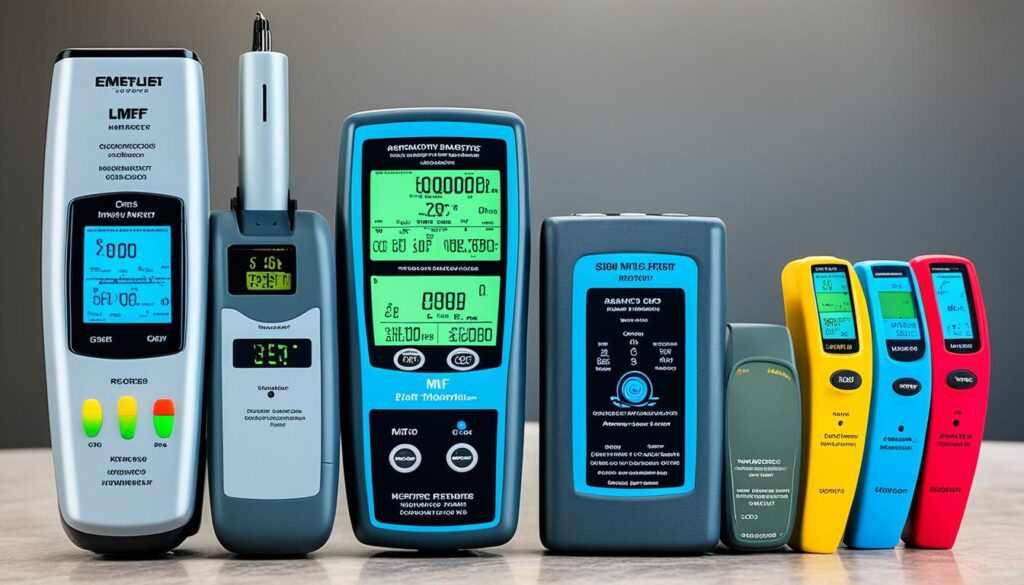
| Meter Type | Measurement Purpose | Units of Measurement |
|---|---|---|
| Low frequency radiation meters | Measure electric and magnetic fields from electrical devices, power cables, and transformers | Volts per meter (V/m), milligauss (mG) |
| High frequency radiation meters | Measure electromagnetic fields from wireless devices like cell phones, Wi-Fi routers, and cell towers | Volts per meter (V/m), microwatts per square meter (μW/m2) |
| Radioactivity meters | Measure radiation from radioactive materials and radon gas | NanoTesla (nT), counts per minute (cpm) |
Choosing the Right EMF Meter
Now that you are familiar with the different types of EMF meters, it’s important to choose the right meter for your specific needs. Consider the following factors:
- Frequency range: Ensure that the meter covers the frequencies relevant to the sources you want to measure.
- Measurement units: Check if the meter uses the appropriate units for the type of radiation you wish to measure.
- Features: Look for features that are essential for accurate EMF measurements, such as data logging and peak hold functions.
- Ease of use: Choose a meter that is user-friendly and provides clear instructions on measurement techniques.
- Manufacturer credibility: Opt for meters from reputable manufacturers with a track record of producing reliable instruments.
- Warranty and customer support: Ensure that the meter comes with a warranty and that the manufacturer provides good customer support.
By considering these factors, you can select an EMF meter that allows you to effectively measure and monitor EMF levels in your environment.
Factors to Consider When Choosing an EMF Meter
When selecting an EMF meter, there are several important factors to consider to ensure that it meets your specific needs and requirements. By considering these factors, you can make an informed decision and choose the right EMF meter for accurate measurements of electromagnetic field levels.
Frequency Range
The frequency range of the EMF meter is crucial as it determines the types of radiation sources that can be detected and measured. It is essential to choose a meter that covers the frequency range of the radiation sources you want to measure. Whether it’s low frequency or high frequency radiation, selecting an EMF meter with the appropriate frequency range ensures accurate readings.
Measurement Span
The measurement span refers to the range of radiation values that the EMF meter can detect and measure. It is important to choose a meter with a wide measurement span, encompassing both low and high radiation levels. This ensures that you can capture a broad range of EMF values and thoroughly assess the electromagnetic field in your environment.
Necessary Features and Ease of Use
The EMF meter should have the necessary features to perform accurate measurements. Look for features such as data logging, graphical displays, and customizable settings that enhance ease of use and provide comprehensive information. Additionally, ensure that the meter has an intuitive interface and clear instructions, making it user-friendly without any confusing buttons or settings.
Ability to Detect Radiation Sources
An important factor to consider is the ability of the EMF meter to detect specific radiation sources. Some meters are designed to identify the type and source of radiation, allowing you to pinpoint specific EMF sources in your environment. This feature can be invaluable when troubleshooting or investigating potential electromagnetic field concerns.
Manufacturer Reputation and Warranty
Choose an EMF meter from a reputable manufacturer known for producing reliable and accurate devices. A reputable manufacturer typically offers a warranty, indicating their confidence in the quality and durability of their product. A reliable warranty provides peace of mind and ensures that any issues with the meter will be addressed by the manufacturer.
Reliable Seller and Customer Support
When purchasing an EMF meter, it is important to choose a reliable seller that offers excellent customer service. Look for a seller with a track record of positive customer experiences, worldwide shipping options, and responsive support. A reliable seller will ensure a smooth purchasing process and provide assistance if any issues arise with your EMF meter.
Helpful Manuals or Videos
Having access to helpful manuals or videos can significantly assist in understanding how to use the EMF meter effectively and interpret the measurement results. Look for an EMF meter that comes with informative manuals or instructional videos that provide detailed guidance on meter usage, interpretation of measurements, and troubleshooting tips.
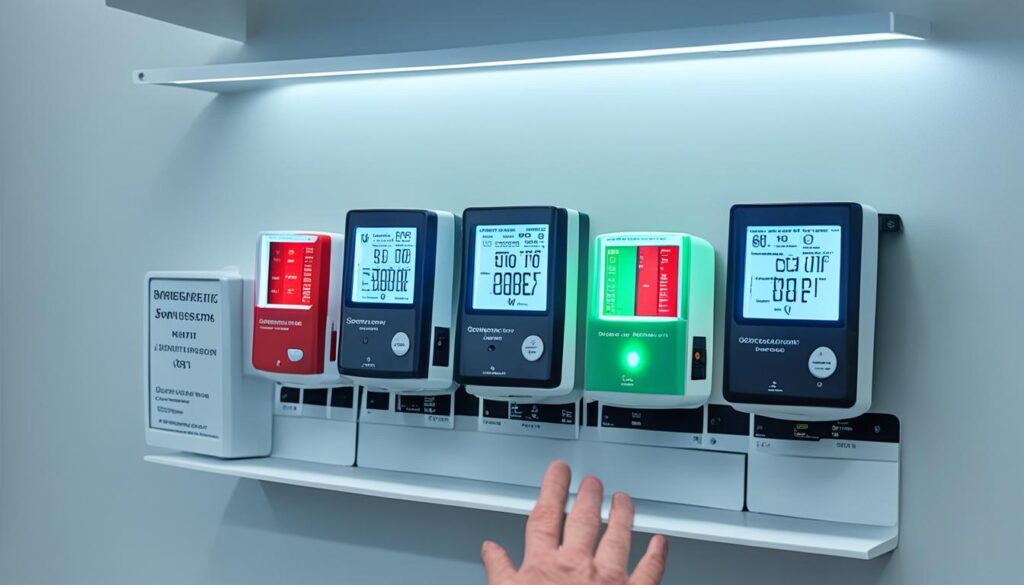
In summary, when choosing an EMF meter, consider factors such as the frequency range, measurement span, necessary features, ease of use, ability to detect radiation sources, manufacturer reputation, warranty, seller reliability, and availability of helpful manuals or videos. Taking these factors into account will ensure that you select the right EMF meter to accurately measure and monitor electromagnetic field levels in your environment.
Steps to Measure EMF Levels in Your Environment
To measure EMF levels in your environment, follow these steps:
- Prepare: Gather the necessary equipment, including the selected EMF meter and any accessories.
- Select Locations: Choose the locations to measure based on the potential presence of EMF sources or areas of concern.
- Calibrate the Meter: Follow the manufacturer’s instructions to calibrate the EMF meter, ensuring accurate measurements.
- Choose the Measurement Technique: Use the appropriate measurement technique based on the type of radiation you are measuring, whether it’s low frequency, high frequency, or radioactivity.
- Record the Data: Take measurements at each location, recording the data while considering the specific units and measurement range of the meter.
- Interpret the Results: Compare the measurement results to established guidelines or safety limits for EMF exposure to interpret the data accurately.
- Take Necessary Precautions: If the measured levels exceed safety limits or if there are significant health concerns, take appropriate steps to reduce EMF exposure in the environment.
By following these step-by-step instructions, you can effectively measure EMF levels in your environment and gain valuable insights into your exposure to electromagnetic radiation.
Conclusion
Measuring EMF levels in your environment is of utmost importance when it comes to understanding and managing your exposure to electromagnetic radiation. Accurate measurement allows you to identify potential health risks and implement the necessary safety precautions to protect yourself and your loved ones.
By selecting the right type of EMF meter and following proper measurement techniques, you can gain valuable insights into your EMF exposure. Consider factors such as the frequency range, features, ease of use, and manufacturer reputation when choosing an EMF meter. These considerations ensure that you have a reliable and effective tool to measure and monitor EMF levels accurately.
Regular monitoring of EMF levels is essential in maintaining a safe and healthy environment. It empowers you to take appropriate actions if the measured levels exceed safety limits or if there are significant health concerns. By being proactive in measuring and managing EMF levels, you can reduce potential risks and create a safer living space for yourself and your family.
Source Links
- https://emf-protection.co.uk/how-to-measure-emf-in-your-home/
- https://www.home-biology.com/electromagnetic-field-radiation-meters/how-to-measure-electromagnetic-radiation
- https://www.ncbi.nlm.nih.gov/pmc/articles/PMC9448713/

Subscribe to Our Newsletter

